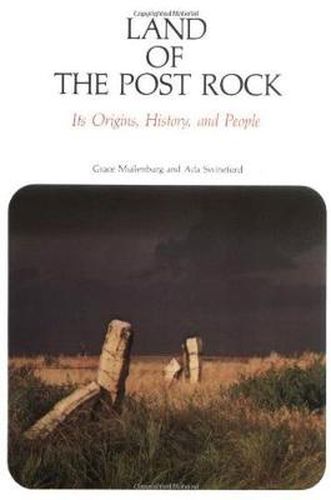Readings Newsletter
Become a Readings Member to make your shopping experience even easier.
Sign in or sign up for free!
You’re not far away from qualifying for FREE standard shipping within Australia
You’ve qualified for FREE standard shipping within Australia
The cart is loading…






In north-central Kansas, where woodlands are sparse and prairies expansive, rows of creamy-buff, brown-striped stone fence posts grace the landscape. These stately posts are shaped from the native rock known as Fencepost limestone, or simply post rock. Now tourist attractions, the posts are also regional trademarks that bespeak the resourcefulness of early Kansas settlers.
Land of the Post Rock is a story of north-central Kansas and its people, and their relationship to the post rock. The authors weave together regional geology, geography, and economics with local history and pioneer folklore to describe how post rock shaped the area’s development. They have recorded the story of a unique aspect of Mid-American heritage.
Post rock played a vital role as the central Kansas upland evolved from a treeless grassland to an area of cultivated farms. Obliged to find a substitute for post timber, early settlers began turning back the sod and splitting posts from the rock layer that for hundreds of centuries had lain dormant. The rock became a central factor in the development of that segment of the plains as dugouts and sod houses gave way to substantial dwellings constructed of stone.
This book contains a generous amount of local oral history. The authors traveled the region collecting stories about the early settlers’ dependence on post rock to survive on prairie homesteads. Here, too, is ethnic history. Details are provided on the backgrounds, talent, and personalities of the European immigrants who settled the area and used the rock.
Those who are curious about the physical nature of post rock and how it was formed will find answers in this book. The authors explain how the rock was quarried, how stone posts were set, and how post rock was prepared for buildings and other structures.
The volume is illustrated with numerous black-and-white photographs, maps, and charts, as well as ten full-color photographs of post-rock scenes and structures. It can serve as a guide for interested explorers, because it includes specific information on where post-rock artifacts and buildings my be observed today. It is a major contribution to the preservation of the post-rock landscape and heritage.
$9.00 standard shipping within Australia
FREE standard shipping within Australia for orders over $100.00
Express & International shipping calculated at checkout
In north-central Kansas, where woodlands are sparse and prairies expansive, rows of creamy-buff, brown-striped stone fence posts grace the landscape. These stately posts are shaped from the native rock known as Fencepost limestone, or simply post rock. Now tourist attractions, the posts are also regional trademarks that bespeak the resourcefulness of early Kansas settlers.
Land of the Post Rock is a story of north-central Kansas and its people, and their relationship to the post rock. The authors weave together regional geology, geography, and economics with local history and pioneer folklore to describe how post rock shaped the area’s development. They have recorded the story of a unique aspect of Mid-American heritage.
Post rock played a vital role as the central Kansas upland evolved from a treeless grassland to an area of cultivated farms. Obliged to find a substitute for post timber, early settlers began turning back the sod and splitting posts from the rock layer that for hundreds of centuries had lain dormant. The rock became a central factor in the development of that segment of the plains as dugouts and sod houses gave way to substantial dwellings constructed of stone.
This book contains a generous amount of local oral history. The authors traveled the region collecting stories about the early settlers’ dependence on post rock to survive on prairie homesteads. Here, too, is ethnic history. Details are provided on the backgrounds, talent, and personalities of the European immigrants who settled the area and used the rock.
Those who are curious about the physical nature of post rock and how it was formed will find answers in this book. The authors explain how the rock was quarried, how stone posts were set, and how post rock was prepared for buildings and other structures.
The volume is illustrated with numerous black-and-white photographs, maps, and charts, as well as ten full-color photographs of post-rock scenes and structures. It can serve as a guide for interested explorers, because it includes specific information on where post-rock artifacts and buildings my be observed today. It is a major contribution to the preservation of the post-rock landscape and heritage.